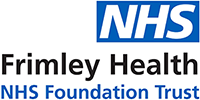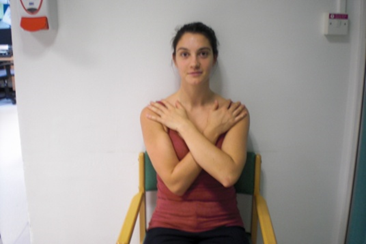Rib fractures patient information
This page contains information about fractured ribs and other chest wall injuries.
Rib fractures are a very common injury. In the elderly, they are often caused by a fall (either from a height or a standing position) whereas in the younger population, they are often caused by road traffic collisions or sports.
Rib fractures normally take about 4-6 weeks to heal, but during this time they can be very painful. One of the main reasons is your chest wall is always moving as you breathe, and unlike other parts of our body, it is difficult to rest.
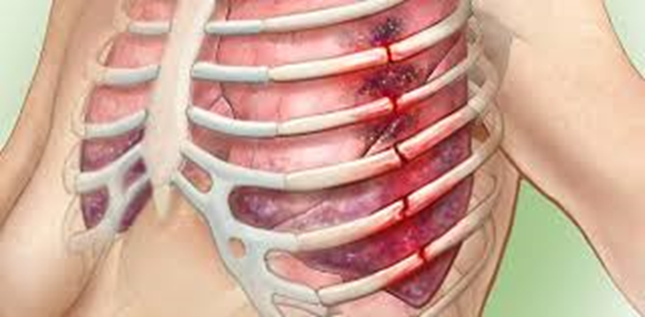
Complications of rib fractures
- Chest Infections
One of the most common complications after rib fractures is a chest infection. When people are in pain, they tend to take more shallow breaths and struggle to cough up sputum (phlegm). Combined with the fact that most patients tend to be slightly less mobile, this can mean that you are more prone to developing a chest infection.
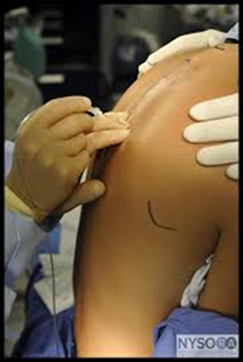 It is very important that your pain is well controlled in order to be able to take a deep breath and cough. It is essential that you take regular painkillers to minimise discomfort.
It is very important that your pain is well controlled in order to be able to take a deep breath and cough. It is essential that you take regular painkillers to minimise discomfort.
If these painkillers do not control your pain, or we think it is necessary, a specialist doctor called an anaesthetist will see you and offer you an epidural or nerve block (paravertebral block) to numb the pain from your fractured ribs.
- Pneumothorax- this is when air gets into the space between the chest wall and the lung. This causes the lung to collapse. This may cause shortness of breath. A small tube (called a chest drain) may need to be inserted between the ribs to remove the air and improve your breathing.
- Haemothorax-this is when blood collects in the space surrounding the lung. This can make the lung collapse. This may cause shortness of breath. A chest drain may be required to remove the blood and improve your breathing.
- Surgical emphysema-this is when air leaks from your lung into the space under your skin. This can cause the skin of your chest to look swollen and sound crackly when pressed.
Not everyone experiences these complications, but if you have any concerns, please speak to any member of staff on the ward.
How are rib fractures diagnosed?
Most people are diagnosed with rib fractures after having a chest x-ray or a CT scan.
How do you treat rib fractures?
There is no specific treatment for rib fractures. The most important thing is controlling your pain and preventing a chest infection.
You will be offered painkillers, anti-sickness medication. Some people require extra oxygen to help with breathing.
The doctors, nurses and physiotherapists will monitor your closely for any signs of an infection, including a raised temperature or a change in the colour of your sputum.
How can I avoid getting a chest infection?
In order to prevent a chest infection, you must do the following:
- Take painkillers regularly - this will enable you to take deep breaths and cough up your sputum. You will receive painkillers from nursing staff on a regular basis. If you have pain between these times, you can request extra painkillers. If you feel that your pain is not well controlled, or if you think you are on too many painkillers, it is important that you tell a nurse or doctor.
- Mobilise - it is essential that you sit out of bed and walk regularly. If you require some assistance the nursing staff and Physiotherapists will help. This is the most effective way of preventing a chest infection.
- Take deep breaths - it is important that every hour you take 5 deep breaths that fill to the bottom of your lungs. This keeps the lungs inflated and allows air to get behind any secretions that need clearing. The Physiotherapists may provide you with a small plastic device called an incentive spirometer so you can measure the volume of your breaths.
- Cough - try to cough up any sputum that is on your chest. You can support the painful area with a pillow or towel.
- Complete daily shoulder exercises (included within this leaflet). This will stop stiffness and maintain full upper limb function.
- Stop smoking – if you are a smoker it is important to stop smoking altogether. Please ask us for help if you need support with stopping smoking. More information can be found at:
NHS.UK stop smoking information
Do not:
- Stay in bed or sit still for a long period of time. This will not allow your lungs to fully expand and will put you at a risk of a chest infection.
- Lift anything heavy that could make your pain worse.
Going home
Once you have gone home, it is important that you stay mobile and continue with your deep breathing exercises and shoulder exercises until you are at your normal level of fitness.
If your job involves a lot of heavy lifting or manual handling, it is advisable to talk to your employer about your duties until your chest wall is pain free and you can mobilise comfortably.
Deep Breathing Exercises with an Incentive Spirometer
It is extremely important that you take 5 deep breaths every hour to fill the bottom of your lungs with air. Your Physiotherapist may provide you with an Incentive Spirometer to measure the volume of these breaths. Please ensure that you complete the following on an hourly basis:
|
1. Insert the mouth piece into your mouth and form a tight seal with your lips. |
 |
|
2. Take a slow, deep breath in for as long as possible. As you do so, the white disk will move and tell you how big your breath is. |
 |
|
3 It is important to clear any sputum that is on your chest. So, after your deep breaths, you should try a supported cough. Place a towel or pillow over your fractured ribs. Gently apply some pressure to the area, take a deep breath and then cough as hard as you can. |
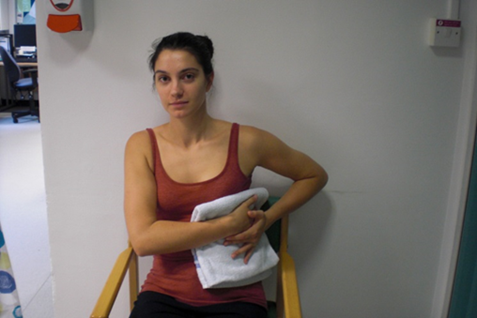 |
Repeat the cough as many times as needed to clear any sputum. If your cough is strong and dry, then you do not need to repeat the cough. If you are struggling to cough because of pain, then please let a member of the ward team know.
Exercise After Rib Fractures
It is extremely important that you complete daily exercises for your shoulder and thoracic spine (the upper part of your spine) to ensure that you maintain full range of movement and function.
The following exercises must be repeated 2-3 times a day.
Aim for 10-15 repetitions of each.
|
1. Thoracic Rotations |
|
|
2. Thoracic Flexion |
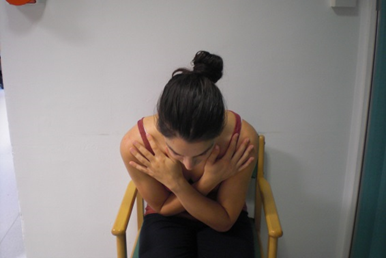 |
|
3. Thoracic Side Flexion |
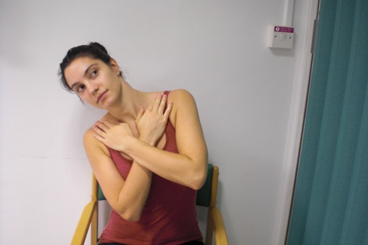 |
|
4. Scapular Setting |
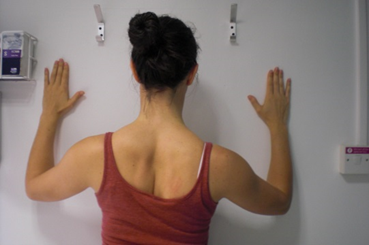 |
|
5. Shoulder Flexion |
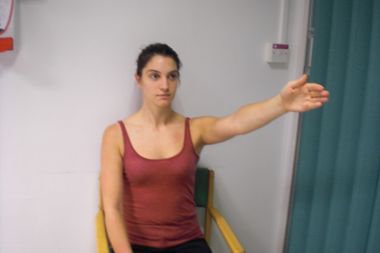 |
|
6. Shoulder Abduction |
 |
If you are struggling with any of these exercises, please let your ward Physiotherapist know.
If you are experiencing any of the following symptoms, please contact your surgical team
- Worsening shortness of breath
- High temperature
- Increased pain
- Green/yellow sputum
- Feeling unwell
Contact information
|
If you were a patient at |
Call |
|
If you were a patient at |
Call: |
If you cannot get in contact, please call 111 |
|
If you feel seriously unwell, call 999 or go
|
|
To access this information in another format or language
Including:
- Large print
- Easy read
- Audio
- Braille
Please contact the patient advice and liaison service (PALS)
Frimley Park Hospital 0300 613 6530
Heatherwood Hospital and Wexham Park Hospital 0300 615 3365
